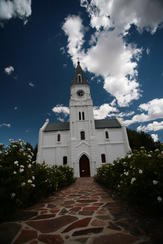Name Change

In the Sneeuberg Mountain Range, the tallest peak, at 2502 m high, is called Kompasberg (Compass Mountain). Governor Joachim van Plettenberg and Colonel Jacob Gordon, who when surveying the area in 1778, decided that from the summit it encompassed a panoramic view of the whole countryside and so named it Kompasberg.
In the southern foothills of these mountains, and dominated by the Kompasberg, lies the quirky town, Nieu Bethesda. Nieu Bethesda, set in the arid Karoo, became established due to the abundant water source from the perennial streams that flow down from the Sneeuberg Mountains.
Andrew Murray, a Dutch Reformed parson from Graaff-Reinet founded the village here in 1875. He named it Bethesda, place of flowing waters, from the Dutch Bible passage; John 5: 2-4, ‘Laten sy dese plaats nu Bethesda noemen’ (Let us now name this place Bethesda). Many years later this was somehow incorrectly translated turning the ‘nu’ (now) into nieu (new), which stuck and is still used today.
Due to the abundant water supply, and by deflecting the flow of the mountain streams to run down the sides of the streets, every plot and garden was entitled to a twice-weekly watering, allowing the village to thrive as an agricultural centre.
The main street is still lined with pear trees and quince hedges, which once formed the boundaries of the plots. By 1886, Nieu Bethesda had grown enough to become a municipality. Today, it is a pleasure to find somewhere so unspoilt by modern development.
Nieu Bethesda is noted in South Africa for its historical architectural purity. Also of interest in the town are the water mills dating back to 1860, and the Dutch Reformed Church, consecrated on 11 February 1905.